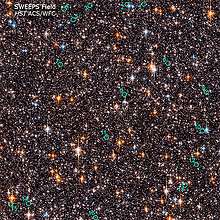CHEOPS
 Artist's impression of the CHEOPS spacecraft bus | |
| Names | CHEOPS |
|---|---|
| Operator |
Swiss Space Office ESA |
| Website |
cheops.unibe.ch/ |
| Mission duration | 3.5 yrs (planned) |
| Spacecraft properties | |
| Bus | SEOSAT platform |
| Manufacturer | Airbus Defence and Space |
| Launch mass | ~300 kg (660 lb) |
| Payload mass | 58 kg (128 lb) |
| Dimensions | 1.5 x 1.5 x 1.5 m |
| Power | ~64 watts[1] |
| Start of mission | |
| Launch date | 2019[2][3] |
| Rocket | Soyuz[4] |
| Launch site |
Guiana Space Centre (Ensemble de Lancement Soyouz) |
| Contractor | Arianespace[2] |
| Orbital parameters | |
| Reference system | Geocentric |
| Regime | Sun-synchronous 6 am/pm |
| Perigee | 700 km (430 mi)[3] |
| Apogee | 700 km (430 mi)[3] |
| RAAN | 6am |
| Main | |
| Type |
Ritchey-Chretien frame-transfer back-side illuminated CCD |
| Diameter | 32 cm (13 in)[3] |
| Focal length | F/8 |
| Wavelengths | 330-1100 nm |
|
| |
CHEOPS (CHaracterising ExOPlanets Satellite) is a planned European space telescope for the study of the formation of extrasolar planets.
CHEOPS is to be ready to launch in early 2019. The mission aims to bring an optical Ritchey–Chrétien telescope with an aperture of 30 cm, mounted on a standard small satellite platform, into a Sun-synchronous orbit of about 700 km (430 mi) altitude. For the planned mission duration of 3.5 years, CHEOPS is to examine known transiting exoplanets orbiting bright and nearby stars.[5]
History
Organized as a partnership between the European Space Agency (ESA) and the Swiss Space Office, CHEOPS was selected in October 2012 from among 26 proposals as the first S-class ("small") space mission in ESA's Cosmic Vision programme.[5] ESA is the mission architect and responsible for the spacecraft and launch opportunity procurement. The project is led by the Center for Space and Habitability at the University of Bern, Switzerland, with contributions from other Swiss and European universities. The principal investigator for the science instrument is Willy Benz from the University of Bern. After a competition phase, Airbus Defence and Space in Spain was selected as the spacecraft builder.[4] The mission is cost capped at €50 million.[4]
Goals
The main goal of CHEOPS will be to accurately measure the radii of the exoplanets for which ground-based spectroscopic surveys have already provided mass estimates. Knowing both the mass and the size of the exoplanets will allow scientists to determine the planets' density and thus their approximate composition, such as whether they are gaseous or rocky. CHEOPS will be the most efficient instrument to search for shallow transits and to determine accurate radii for known exoplanets in the super-Earth to Neptune mass range (1-6 Earth radius).[4]
CHEOPS will measure photometric signals with a precision limited by stellar photon noise of 150 ppm/min for a 9th magnitude star. This corresponds to the transit of an Earth-sized planet orbiting a star of 0.9 Rsun in 60 days detected with a S/Ntransit >10 (100 ppm transit depth). For example, an Earth-size transit toward a G star creates an 80 ppm depth.
The spacecraft is to be powered by solar panels that are also part of its sunshield. They will provide 60 W continuous power for instrument operations and allow for at least a 1.2 gigabit/day data downlink capacity.[6]
See also
References
- ↑ CHEOPS - Executive Summary
- 1 2 "CHEOPS will ride on a Soyuz rocket". cheops.unibe.ch. 6 April 2017. Retrieved 19 September 2017.
- 1 2 3 4 CHEOPS - Mission Status & Summary
- 1 2 3 4 CHEOPS exoplanet mission meets key milestones en route to 2017 launch. ESA, 11 July 2014
- 1 2 "ESA Science Programme's new small satellite will study super-Earths". ESA press release. 19 October 2012. Retrieved 19 October 2012.
- ↑ CHEOPS - Requirements
External links
- CHEOPS ESA homepage
- CHEOPS homepage
- Europe to begin search for habitable planets in our cosmic backyard, 22 October 2012, Stuart Clark, The Guardian
- CHEOPS mission visualization - video
- Video (86:49) - Search for Life in the Universe – NASA (July 14, 2014).


